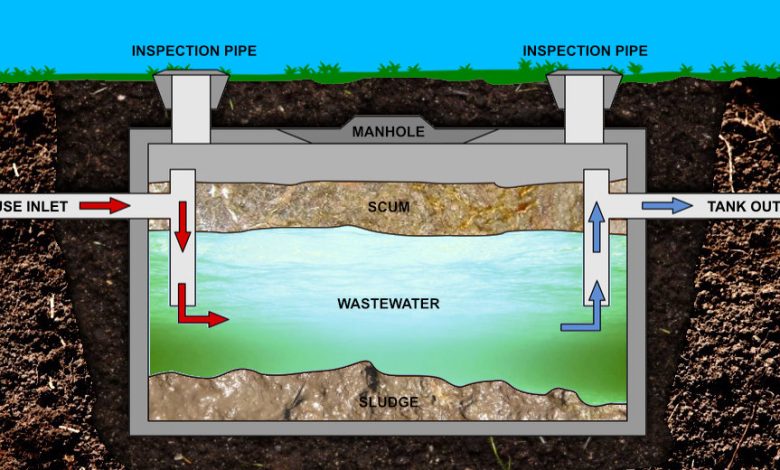How Does a Septic Tank Work?

If you live in a rural area or a property that’s not connected to a municipal sewer system, chances are you rely on a septic tank. Septic tanks are essential for managing household wastewater, and understanding how they work can help you maintain your system properly. In this article, we’ll answer the question: how does a septic tank work? Explore the inner workings of septic systems in detail.
What Is a Septic Tank?
A septic tank is an underground chamber typically made of concrete, fiberglass, or plastic, used to treat wastewater from households. It’s part of a larger septic system that includes a drain field, also known as a leach field. This self-contained system is designed to break down waste, separate solids from liquids, and allow for the safe disposal of wastewater into the surrounding soil.
The primary function of a septic tank is to collect wastewater from your home and use natural processes to separate and treat the waste. But to understand how do septic tanks work, we need to break down the process step by step.
How Does a Septic Tank Work? – The Basics
At its core, a septic tank works through a combination of biological digestion and gravity. Wastewater from your home flows into the tank, where heavier solids settle at the bottom, while oils and lighter particles float to the top. The system relies on anaerobic bacteria (bacteria that thrive without oxygen) to break down the organic material in the waste. Here’s a closer look at the key stages:
1. Wastewater Enters the Tank
When you use water in your home—whether flushing a toilet, taking a shower, or using the dishwasher—the wastewater flows from your house into the septic tank through a main drainage pipe. This pipe is usually connected to every drain in your home, sending all types of wastewater into the septic tank for treatment.
2. Separation of Solids and Liquids
Inside the septic tank, the wastewater separates into three layers:
- Scum Layer: This top layer consists of oils, grease, and lighter particles that float to the surface.
- Effluent Layer: The middle layer is composed of relatively clear liquid, known as effluent, which eventually exits the tank and flows into the drain field.
- Sludge Layer: The heaviest materials, including solid waste and inorganic substances, sink to the bottom, forming a layer of sludge.
3. Bacterial Breakdown
The bacteria inside the septic tank play a crucial role in breaking down the organic matter within the sludge and scum layers. These anaerobic bacteria decompose solid waste, reducing its volume and transforming it into simpler substances. This process helps prevent the tank from filling up too quickly.
4. Effluent Flow to the Drain Field
As the bacteria work to break down waste, the liquid effluent in the middle layer is pushed out of the septic tank and into the drain field. The tank is designed with an outlet pipe that allows the effluent to flow out once it reaches a certain level. The effluent is mostly clear but still contains bacteria and small amounts of organic material.
5. Filtration in the Drain Field
The effluent flows into the drain field, where it is further treated by percolating through the soil. The soil acts as a natural filter, removing harmful bacteria, viruses, and nutrients before the water reenters the groundwater supply. A properly functioning drain field prevents contamination of nearby water sources.
6. Regular Maintenance
Septic tanks are not entirely self-sustaining. Over time, the sludge and scum layers accumulate and need to be pumped out to maintain the system’s efficiency. Without regular maintenance, the tank can overflow, leading to system failure and costly repairs.
How Do Septic Tanks Work Efficiently?
Now that we’ve covered the basic function of septic tanks, you might wonder how do septic tanks work efficiently for years without problems? The key lies in proper usage and regular maintenance. Here are a few best practices:
1. Avoid Flushing Harmful Materials
Septic systems are designed to handle organic waste and wastewater. Flushing non-biodegradable materials, such as wipes, feminine hygiene products, and diapers, can clog the system and cause it to malfunction. Similarly, avoid pouring grease or oil down the drain, as these substances can build up in the scum layer and block the outlet pipe.
2. Regular Pumping
The sludge layer at the bottom of the tank will continue to build up over time. Most septic tanks should be pumped every three to five years, depending on the size of the tank and the amount of wastewater generated in the household. Regular pumping prevents the tank from overflowing and causing backups.
3. Conserve Water
Excessive water usage can overwhelm your septic system, causing it to process more wastewater than it was designed to handle. Simple actions like fixing leaky faucets, using water-efficient appliances, and spacing out laundry loads can help reduce the strain on your septic tank.
4. Protect the Drain Field
The drain field is a crucial part of the septic system’s filtration process. Avoid planting trees or shrubs near the drain field, as their roots can interfere with the pipes. Additionally, don’t park vehicles or heavy machinery on the drain field, as compacted soil can prevent the effluent from filtering properly.
Common Problems and Solutions
Even with proper care, septic tanks can sometimes experience issues. Here are a few common problems and their solutions:
1. Clogged Drain Field
If the drain field becomes clogged, wastewater will have nowhere to go, leading to backups in your home. This can happen if the tank is not pumped regularly, allowing too much solid waste to flow into the drain field. The solution is to pump the tank and, in some cases, replace parts of the drain field.
2. Tank Overflow
If the septic tank fills up too quickly, it may overflow, causing untreated waste to seep into your yard. This problem can usually be avoided by following a regular pumping schedule and conserving water.
3. Odors
If you notice foul odors near the tank or drain field, it could indicate a problem with the system. Check for leaks, blocked vents, or clogs. Pumping the tank often resolves odor issues.
Conclusion
Understanding how does a septic tank work? is crucial for any homeowner relying on this system for wastewater management. Septic tanks use natural processes to separate, treat, and safely dispose of household waste. By following best practices, such as avoiding harmful materials, conserving water, and scheduling regular maintenance, you can ensure your septic system works efficiently for years to come.
If you ever encounter problems or need professional assistance with your septic tank, don’t hesitate to reach out to a local expert. Keeping your septic system in good condition will protect both your property and the environment.






